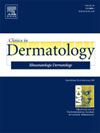斯皮茨黑色素瘤
IF 2.2
4区 医学
Q2 DERMATOLOGY
引用次数: 0
摘要
人们早已认识到,斯皮茨痣与黑色素瘤之间的组织病理学鉴别诊断有时异常困难。两者都可以由大的卵圆形或纺锤形黑色素细胞组成,具有丰富的细胞质和大的细胞核。近十年来的基因组研究表明,Spitz 肿瘤的遗传起始事件多种多样,而每种起始事件又分为良性、中级和恶性病变。另一个发现是,有些黑色素瘤在形态上与 Spitz 肿瘤相似,但却有传统的起始基因突变(如 BRAF、NRAS)。目前世卫组织对 Spitz 肿瘤的定义将其范围限定为具有影响 MAP 激酶通路的激活突变的肿瘤,其中大多数是涉及激酶基因的融合。将斯皮茨瘤从其他形态上仅为斑点状的肿瘤中分离出来是否能经受住时间的考验尚不确定,但就目前而言,它确实为这个一直复杂的领域带来了秩序。对斯皮茨黑色素瘤的认识将有助于对这一重要的肿瘤群体进行分类、随访和制定合理的治疗指南,而这些肿瘤大多发生在年轻人身上。我回顾了世界卫生组织对斯皮茨肿瘤定义的逻辑、起始突变产生的肿瘤谱系、斯皮茨黑色素瘤定义中存在的问题,并结合相关肿瘤举例说明了这一罕见实体。本文章由计算机程序翻译,如有差异,请以英文原文为准。
Spitz melanoma
It has long been recognized that the histopathologic differential diagnosis between Spitz nevus and melanoma is sometimes extraordinarily difficult. Both can be composed of large oval to spindled melanocytes with abundant cytoplasm and large nuclei. Genomic studies over the last decade have clarified that Spitz tumors have diverse genetic initiating events, and that for each of these, there are benign, intermediate grade, and malignant lesions. Another discovery is that some melanomas can resemble Spitz tumors morphologically but have conventional initiating mutations (eg, BRAF and NRAS). The current World Health Organization definition of Spitz tumors restricts the spectrum to neoplasms with an activating mutation affecting the MAP kinase pathway, mostly fusions involving kinase genes. Whether splitting off Spitz tumors from other neoplasms that are only morphologically spitzoid will stand the test of time is uncertain, but for now, it does bring order to what has been a complex area. The recognition of Spitz melanoma will enable classification, follow-up, and the delineation of rational treatment guidelines for this important group of tumors, most of which are in young people. The author reviewed the logic of the World Health Organization definition of Spitz tumors, the spectrum of tumors produced by initiating mutations, and problems with the definition of Spitz melanoma and provides an example of this rare entity in the context of related tumors.
求助全文
通过发布文献求助,成功后即可免费获取论文全文。
去求助
来源期刊

Clinics in dermatology
医学-皮肤病学
CiteScore
4.60
自引率
7.40%
发文量
106
审稿时长
3 days
期刊介绍:
Clinics in Dermatology brings you the most practical and comprehensive information on the treatment and care of skin disorders. Each issue features a Guest Editor and is devoted to a single timely topic relating to clinical dermatology.
Clinics in Dermatology provides information that is...
• Clinically oriented -- from evaluation to treatment, Clinics in Dermatology covers what is most relevant to you in your practice.
• Authoritative -- world-renowned experts in the field assure the high-quality and currency of each issue by reporting on their areas of expertise.
• Well-illustrated -- each issue is complete with photos, drawings and diagrams to illustrate points and demonstrate techniques.
 求助内容:
求助内容: 应助结果提醒方式:
应助结果提醒方式:


